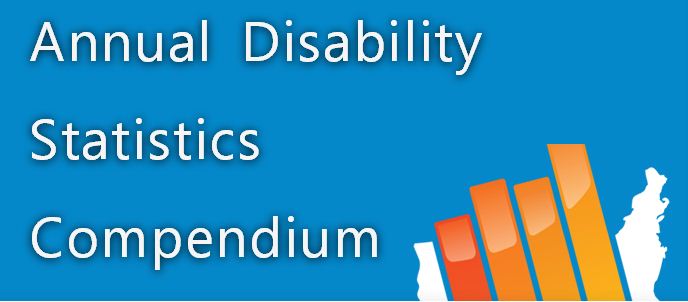A Publication of the Rehabilitation Research and Training Center on Disability Statistics and Demographics
The 2015 Disability Statistics Annual Report is a companion volume to the 2015 Annual Disability Statistics Compendium. The Compendium presents many tables of data, including state and national values and trends over time. The Annual Report presents statistics from the 2015 Annual Disability Statistics Compendium tables to address the following types of questions:
• How many people with disabilities live in the United States?
• What is the disability percentage in different age groups?
• What is the disability percentage for different types of disability?
• To what extent are people with disabilities employed?
• What are the earnings for people with and without disabilities?
• What is the poverty percentage for people with and without disabilities?
• Is disability status associated with percentages of smoking, obesity, and binge drinking?
The Annual Report highlights state and trend data, and complements the detailed tables available in the Compendium. There is a great deal of variability in disability rates by state and the Annual Report includes maps to highlight this information; each map is related to a specific table from the 2015 Compendium. A specific listing of source data for each figure is included in Appendix B. A glossary of terms is included in Appendix C.
Quick Facts
• The American Community Survey (ACS) estimates the overall rate of disability in the US population in 2014 was 12.6%.
• The percent of persons with disability as well as employment and poverty rates and earnings and health measures of people with disabilities vary greatly by state.
• The percentage of those with a disability in the United States civilian population rose from11.9 in 2010 to 12.6 in 2013 and 2014.
• The lowest percentage of a population having a disability in a state was 9.6% (Utah); the highest was over twice as high with a percentage of 19.9% (West Virginia).
• Rates of disability increase with age. In 2014, in the population under 5 years old, less than 1.0% of the population had a disability. For the population ages 5-17, the rate was 5.4%. For ages 18-64, the rate was 10.5%. For people ages 65 and older, 36.0% had a disability.
• In 2014, of the US population with disabilities, over half (51.6%) were people ages 18-64. Forty percent (40.7%) of people with disabilities were 65 and older, while children and youth with disabilities accounted for only 7.3% (ages 5-17) and 0.4% (under 5 years old).
• All disability types (hearing, vision, cognitive, ambulatory, self-care, and independent living) have increases in disability percentages with age, however cognitive shows the least change between age groups.
• In 2014, 34.4% of US civilians with disabilities ages 18-64 living in the community were employed, compared to 75.4% for people without disabilities – a gap of 41 percentage points.
• There is state variation in the rates of employment for persons with disabilities, from a high of 50.1% to a low of 25.6%; for people without disabilities, state rates ranged from 83.9% to 70.4%.
• Employment rates vary by type of disability. Employment rates are highest for people with hearing disabilities (50.7%) and vision disabilities (40.2%) and lowest for people with self-care (15.4%) and independent living (15.9%) disabilities.
• According to 2014 data, the median earnings of US civilians with disabilities ages 16 and over was $21,232, about two-thirds of the median earnings of people without disabilities ($31,324).
• Almost thirty percent (28.1%) of US civilians with disabilities of working-age in 2014 were living in poverty. For US civilians of working-age without disabilities, the national poverty rate was 13.3%.
• The US rate for smoking for people with disabilities was 24.5% in 2014, much higher than the rate of 15.3% for people without disabilities.
• In 2014, the US obesity rate for people with disabilities was 41.1%. For people without disabilities, the obesity rate was 25.2%.
• The 2014 state rates for binge drinking among people 18 and over with disabilities ranged from 6.6% to 17.8%. Among people 18 and over without disabilities, the binge drinking rates were higher, varying from 11.0% to 26.6%.
To read the complete report go to http://www.disabilitycompendium.org/docs/default-source/2015-compendium/annualreport_2015_final.pdf

